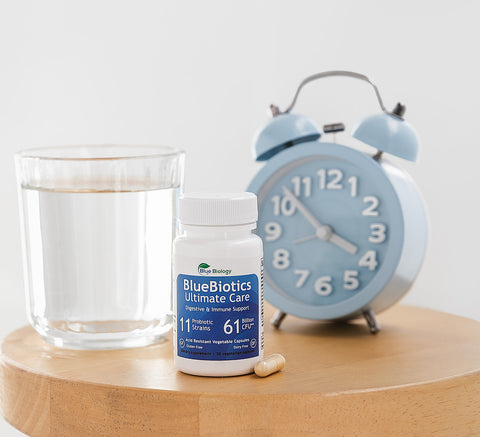Best Time to Take Probiotics
Share

If you're wondering when is the best time to take probiotics, you may be startled by all the conflicting information out there.
Some say to take probiotics with your morning meal. Others say to take them before, with or after any meal of the day, or any combination of these.
So who's right, and when really is the best time to take probiotics?
As with any health-related questions, it's important to take a look at the science, which is what we'll do here.
What the Science Says
There isn't an extensive amount of research into the best time to take probiotics. But we do have some scientific evidence that we can take into consideration.
The most conclusive evidence we currently have is from a 2011 study titled 'The impact of meals on a probiotic during transit through a model of the human upper gastrointestinal tract' that was conducted at the Food Research and Development Centre in Quebec, Canada. (1)
Researchers from this study actually went so far as to have made an artificial human digestive tract to study the effects of taking probiotics with or without food.
In short, this study found that the best time to take probiotics is either:
- With a meal
- 30 minutes before a meal
Why You Should Take Probiotics With a Meal or Within 30 Minutes Before
Probiotics have some potentially great benefits that can legitimately improve quality of life. However, in order to provide these benefits, probiotic microorganisms must make the journey safely past the stomach and to the gut.
That’s easier said than done, though. The reason being is because of the acidic environment of the stomach.
The acid found in our stomachs is there not just to aid in digestion by breaking down food, but also to kill off potentially harmful pathogens that we might ingest along with our food. It's a necessary component of our digestive systems but makes it difficult to get friendly probiotic microorganisms where they need to reach.
Probiotic bacteria and yeast are sensitive microorganisms that are susceptible to not just stomach acids but high temperatures as well. The overall condition of your digestive system is one component that determines whether they'll survive the journey or not. Your digestive environment can either allow good probiotic bacteria to thrive or bad bacteria and other pathogens to take over and cause you to get sick.
The thinking goes that probiotics are more likely to reach the intestines unharmed when consumed slightly before or with food because they're exposed to less of the harsh acid of the stomach this way. Food essentially functions as a vehicle to assist probiotics in getting to the small and large intestines.
What About Prebiotics? Are Probiotics Enough?
Prebiotics are essentially non-digestible fibers and they're the food that probiotics eat. They're an important piece of the puzzle when it comes to promoting a healthy, well-balanced gut.
Probiotics will still be able to reach the gut and provide health benefits without prebiotics, just less of them will survive and will likely not live as long.
Prebiotics are plant-based and are made up of dietary fiber, which is what probiotics consume. Some examples of prebiotics include onions, garlic, bananas, leeks, seaweed, flaxseed, cocoa, apples, barley, oats, asparagus and Jerusalem artichokes.
Which Probiotic Strains to Take
The odds of probiotics surviving all the way to your gut is based on more than just when you take them.
Some strains are more resilient to stomach acid and other harsh environments than other probiotic strains. Lactobacillus and bifidobacterium species are known to be some of the more resilient probiotics and have a higher survival rate.
Certain strains within those species are more adept at surviving as well; one study found that L. rhamnosus GG had the highest survival rate among lactobacillus probiotics.
Other Factors to Take into Consideration
The number of CFU, or colony-forming units, is important to take into consideration when choosing a probiotic supplement as well. The reality is that many of the probiotic microorganisms in a probiotic supplement won't survive the journey to the intestines, where they pass off their health benefits.
Probiotics can be killed off by being exposed to excessive light, heat, or by our stomach acid. You can better ensure that probiotics survive the journey in a couple of ways.
The first is to buy probiotic supplements with a higher CFU count. BlueBiology Ultimate Care contains a potent 61 billion CFU. Some probiotics may die off before they can reach the intestines but more probiotic microorganisms you start off with, the more likely there will be an adequate amount to be effective.
The second thing to look for when buying probiotics is enteric-coated capsules. Probiotics won't be effective unless they reach the intestines, and enteric-coated capsules are the best-known method of getting them there safely.
Enteric-coated capsules do this by being resistant to dissolving in low pH environments (which is what the stomach is) and disintegrating quickly in high pH environments like the intestines.
The Bottom Line
The best time to take probiotics is either with a meal or within 30 minutes before. If you’ve had experience with an upset stomach from taking pills on an empty stomach, take them at mealtime.
There's no evidence indicating that taking them with a certain meal of the day is better, so feel free to take them with breakfast, lunch, or dinner.
Sources

